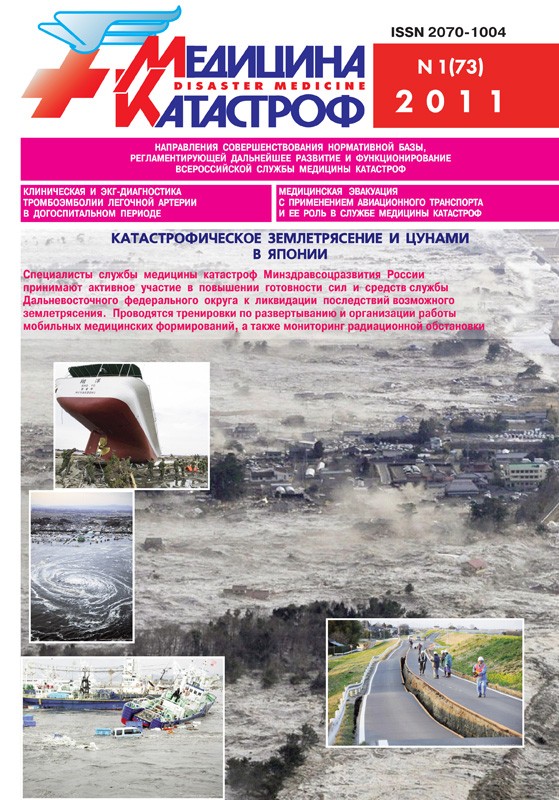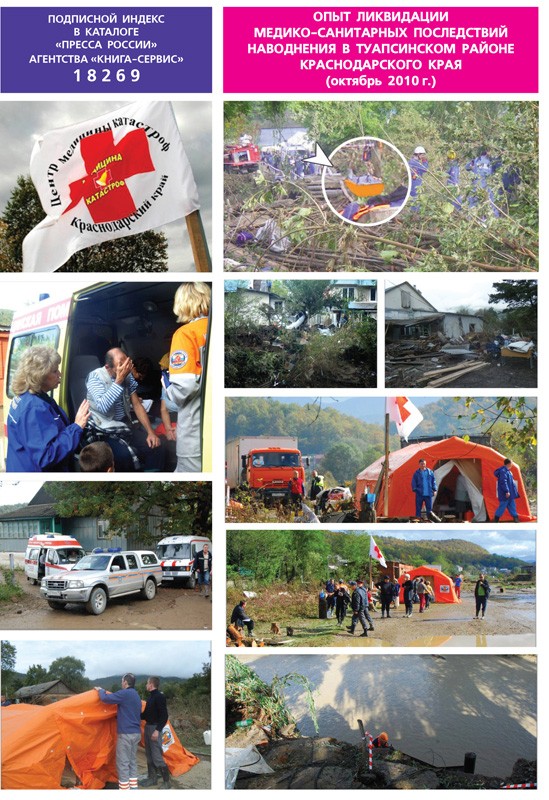ORGANIZATION AND TACTICS OF DISASTER MEDICINE SERVICE
1. Goncharov S.F., Sakhno I.I., Fisun A.Ya., Bobiy B.V. Areas for Perfection of Legal Framework of Further Development and Functioning of All Russian Service for Disaster Medicine
The major compelling reasons for the need for perfection of legal framework of All Russian Service for Disaster Medicine (ARCDM) are presented.
The provisions of current and forthcoming basic regulatory enactments that govern organization and activity of ARCDM are analyzed in detail. Specific tasks of different levels of the Service are defined in this connection. The main directions of further development and functioning of ARCDM are discussed.
Key words: agency of administration, All Russian Center for Disaster Medicine «Zaschita», All Russian Service for Disaster Medicine, ARCDM operations headquarters, data base on manpower and resources of ARCDM, emergency situation, information exchange system, medical care, medical evacuation, normative and methodological base, territorial centre for disaster medicine
2. Borisenko L.V., Garmash O.A., Popov A.V., Pichugin V.Yu. Medical Evacuation by Air and its Part in Service for Disaster Medicine
Problems of medical evacuation by air are analyzed and its part in service for disaster medicine is presented. Some measures for perfection of specialized emergency medical care with use of air medical service are suggested.
Key words: air medical service; air transport; emergency medical care, consultation service and medical evacuation units; financing; medical evacuation; service for disaster medicine; specialized emergency medical care
3. Avetisov G.M., Grachyov M.I., Frolov G.P. Integrated Emergency Response Exercise at Smlensk Nuclear Power Plant «Desna-2010»
The course and the results are presented of integrated emergency response exercise at Smolensk nuclear power plant «Desna-2010» that took place in September 2010. The problems are discussed the positive solution of which will allow enhancement of emergency preparedness of the service for disaster medicine of Ministry of Health and Social Development of Russia for medical support of population in case of a radiation accident.
Key words: deactivation, decontamination, evacuation, firefighting, first aid, integrated emergency response exercise, iodine prophylaxis, protective shelter, radiation accident, radiological reconnaissance, Smolensk nuclear power plant
4. Ivanov P.E., Pogodin A.Yu. Military Doctrine of Russian Federation and Part of Service for Disaster Medicine in Internal Armed Conflict Environment
The main provisions of Military Doctrine of the Russian Federation are considered. The main features of internal armed conflict are defined. The part of service for disaster medicine in internal armed conflict is described.
Key words: armed conflict, internal armed conflict, medical support of troops and population, Military Doctrine of the Russian Federation, service for disaster medicine
CLINICAL ASPECTS OF DISASTER MEDICINE
5. Ermolaev A.A., Plavunov N.F., Spiridonova E.A., Stazhadze L.L. Clinical and ECG Diagnostics of Pulmonary Embolism at Prehospital Stage
The analysis is done of clinical implications of pulmonary embolism in 242 patients at prehospital stage. A detailed analysis is presented of clinical and ECG implications of pulmonary embolism with due consideration of haemostatic status, respiratory function, central nervous system status of patients. The conclusion is drawn on importance of the issues discussed and their complexity in the everyday clinical context.
Key words: clinical diagnostics, ECG diagnostics, pulmonary embolism, prehospital stage
6. Beganova T.V., Manevsky A.P., Preobrazhensky V.N. Programs of Prophylaxis and Rehabilitation of Persons in Hazardous Occupations as Part of Realization of Strategy of Prophylactics and Control of Noninfectious Diseases and Traumatism in Russian Federations
The rating of risk factors of cardiovascular diseases in people in hazardous occupations is carried out and stress and depression are proved to be the leading ones with dislipoproteinemias, smoking, obesity and other factors being of less importance. The conclusion is drawn on need of new computer-based diagnostics and rehabilitation technologies like Bemer therapy and sensory rooms for risk mitigation.
Key words: cardiovascular diseases, computer-based diagnostics, medical rehabilitation programs, mental disorders, people in hazardous occupations, prophylaxis, rehabilitation technologies, risk factors
7. Belevitin A.B., Fesyun A.D., Bozhchenko A.A., Soukhonos Y.A., Fedoseev V.M. Medical Rehabilitation within the Framework of Medical Support of Force Structures of the Russian Federation: Methodological, Historical and Organizational Aspects
The authors present the origin, evolvement and development of organizational forms of medical rehabilitation within the framework of medical support of force structures in peace- and war-time. Some space and time conditions of practical activity of a doctor specialist in the field of medical support management are analyzed. An important social-economic problem of optimization of administration of medical rehabilitation process in present-day conditions is discussed.
Key words: force structures, medical rehabilitation, medical service, medical support system
8. Rozinov V.M., Yandiev S.I. Elastic Stable Intramedullary Osteosynthesis of Femoral Shaft Fractures in Children
The analysis is done of outcomes of 115 children (119 fractures) with femoral shaft fractures when treated by the method of elastic stable intramedullary osteosynthesis. Absolute and relative indications are presented for the use of the method in children of early and pre-school age as well as average activation length after the treatment depending on the age of patients and the type of fracture.
It is noted that fracture union in all operated children happened within optimal term with no pyoinflammatory complications, secondary fragment displacement, implant migration or ruptures, growth disturbance in operated segments.
Key words: children, elastic nails, elastic stable intramedullary osteosynthesis femoral bone, shaft fractures, surgical management
9. Zhovnerchuk E.V. Analysis of Influence of Professional Hazards on Mental Health of Servicemen on Alert Duty
The peculiarities of professional activity of military operators on alert duty in special facilities are considered. Professional hazards and particular work environment are studied and the factors influencing health status and performance capability of the operators are identified. The conclusion is drawn that the specific conditions of operators’ functioning in underground installations cause additional psychic traumas and may lead to psychological disadaptation which in its turn can be accompanied with lower level of professional activity and can promote psychic disorders.
Key words: alert duty, mental health, professional hazards, psychoprophylaxis, servicemen, underground installations
10. Reznik A.M. Psychic Disorders in Local Wars Veterans Treated at Psychiatric In-patient Clinics
Duration, intensity and clinical structure of psychic disorders in local wars veterans treated at psychiatric in-patient clinics are considered. The conclusion is drawn that the main challenge of combat fatigue is its consequences that can last for many years after the war end.
Key words: combat fatigue, local wars veterans, psychiatric in-patient clinic, psychic disorders, treatment
11. Stepanov A.V., Gundorova R.A., Kvasha O.I., Nurmamedov R.A., Dzhioeva A.V. Concomitant Eye Injuries under the Conditions of Extreme Situations
The results of treatment of 164 patients (214 eyes) with concomitant eye traumas inflicted under extreme situation conditions. The patient were designated into 6 groups depending on the type of concomitant trauma. The peculiarities of traumas and treatment tactics were defined in every group and the outcomes studied. The basic principles of ophthalmologic management of such patients were formulated.
Key words: concomitant eye injury, extreme situation, ophthalmologic care
MEDICAL ASPECTS OF ROAD TRAFFIC SAFETY
12. Ter-Ovakimyan A.V., Babaskin D.B., Mosolova Eh.G., Mashkov S.O. Efficacy of Combined Use of Cycloferon and Low Intensity Laser Therapy in Complex Rehabilitation Treatment of Road Traffic Accident Casualties
The results are presented of complex rehabilitation treatment of discogenic damage of spine in road traffic casualties with use of immunomodulator – cycloferon and low intensity laser in combination with detensor-therapy method. The conclusion is drawn that this treatment promotes normalization and improvement of both objective and subjective criteria and promotes higher life quality of the patients.
Key words: casualties, complex rehabilitation treatment , cycloferon, low intensity laser therapy, road traffic accidents
EDUCATION AND TRAINING OF PERSONNEL
13. Reshetnikov V.A., Bulatov M.R., Zubkov I.A. Indices of Subjective Assessment of Readiness of Medical Personnel for Work in Emergency Environment
The results are presented of a special sociological survey of military and civilian medical personnel of Armed Forces and Internal troops of Internal Affairs Ministry of Russia to assess the level of satisfaction with service (work) conditions within health systems of the agencies and to identify the reasons for the down-drift of the index. The importance of factors of service motivation is shown. The analysis is done of the data on subjective assessment of readiness of different groups of medical personnel for functioning in emergency environment.
Key words: armed forces, civilian medical personnel, Internal troops, job satisfaction, military medical personnel, readiness for work in emergency environment
14. Grebenyuk A.N.,Davydova E.V., Sidorov D.A. Organization of Preparation of Students of Medical Higher Education Institutions within Framework of «Extreme and Military Medicine» Program
Some materials on methods of teaching of students of medical higher education institutions within the framework of «Extreme and Military Medicine» program are presented.
Key words: extreme and military medicine, medical countermeasures, radiation biology, teaching, toxicology
EXPERIMENTAL STUDIES
15. Neroev V.V., Bykov V.P., Kvasha O.I., Belyovtseva T.A. New Method of Posttraumatic Glaucoma Treatment (Experimental Research)
A new version of hypotensive posttraumatic glaucoma surgery with use of micro drainage made of biologically compatible material – polifilament carbon thread. The experiment results are considered – the steady hypotensive effect throughout the long (15 months) observation period, absence of inflammatory or dystrophic complications in the tissue surrounding the thread.
Key words: emergency situation, micro drainage, polifilament carbon thread, posttraumatic glaucoma, surgery
REVIEWS
16. Voynovsky E.A., Koltovich A.P. Surgery Tactics «Damage Control» in Vessel Injury Management (Literature Review)
A literature review is presented on use of surgery tactics «damage control» in management of vessel injuries. It is noted that since the basic principle of the tactics is hemostasis the best results are achieved when larger vessels are affected.
Key words: hemostasis, surgery tactics «damage control», vessel injuries
SHORT REPORTS
17. Kosmodem’yansky L.V., Bashir-Zade T.S. Retrospective Analysis of Morbidity in Persons in Hazardous Occupations with Disturbed Intersystem Interaction
The results are presented of retrospective analysis of morbidity of acute respiratory infections and influenza as well as of detection of vegetative-vascular dystonia in persons in hazardous occupations with disturbed intersystem interaction.
Key words: acute respiratory infections, influenza, intersystem interaction disorders, morbidity, persons in hazardous occupations, retrospective analysis, vegetative-vascular dystonia
INFORMATION
18. Burlutskaya A.V. Experience of Liquidation of Medical and Sanitary Consequences of Flood in Tuapse Region of Krasnodar krai (October 2010)



